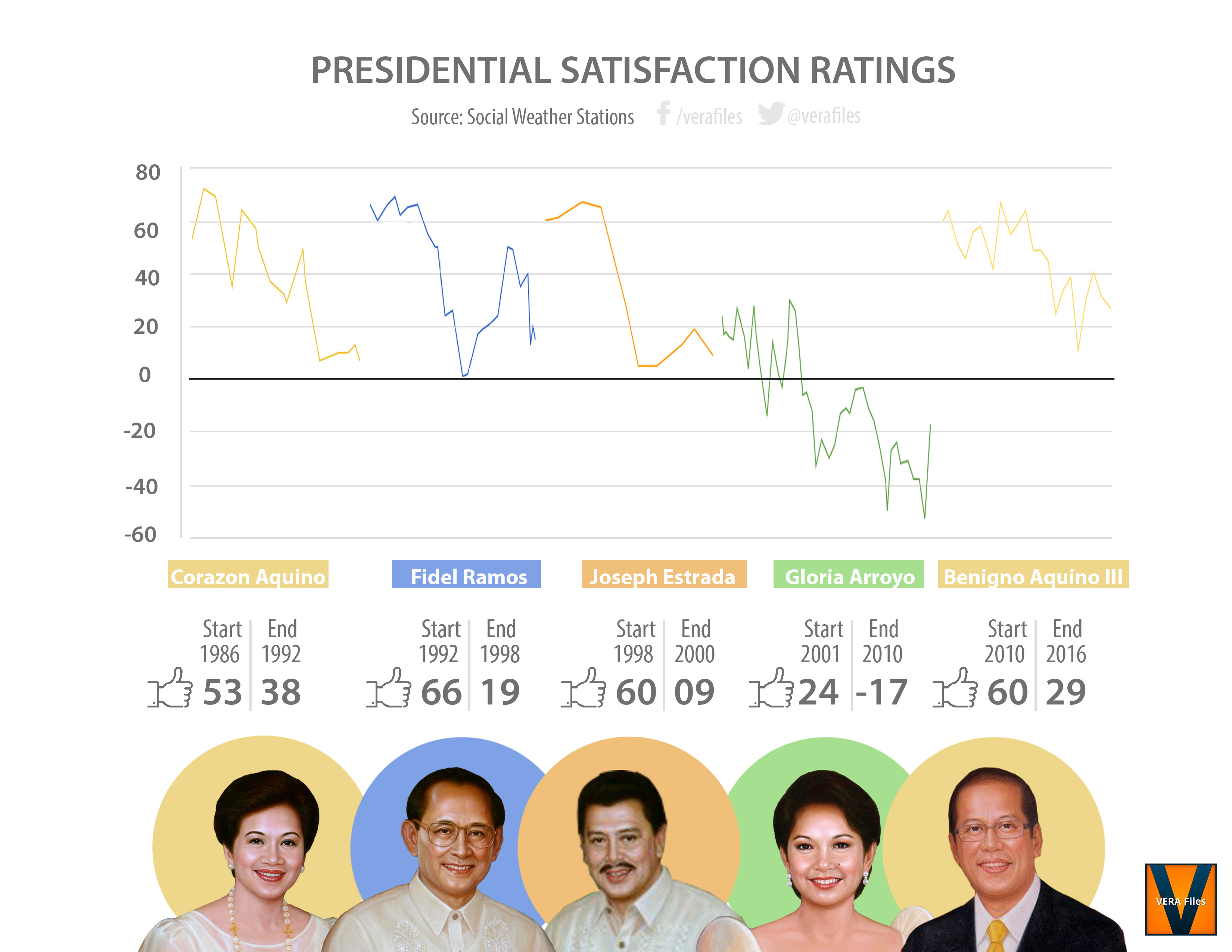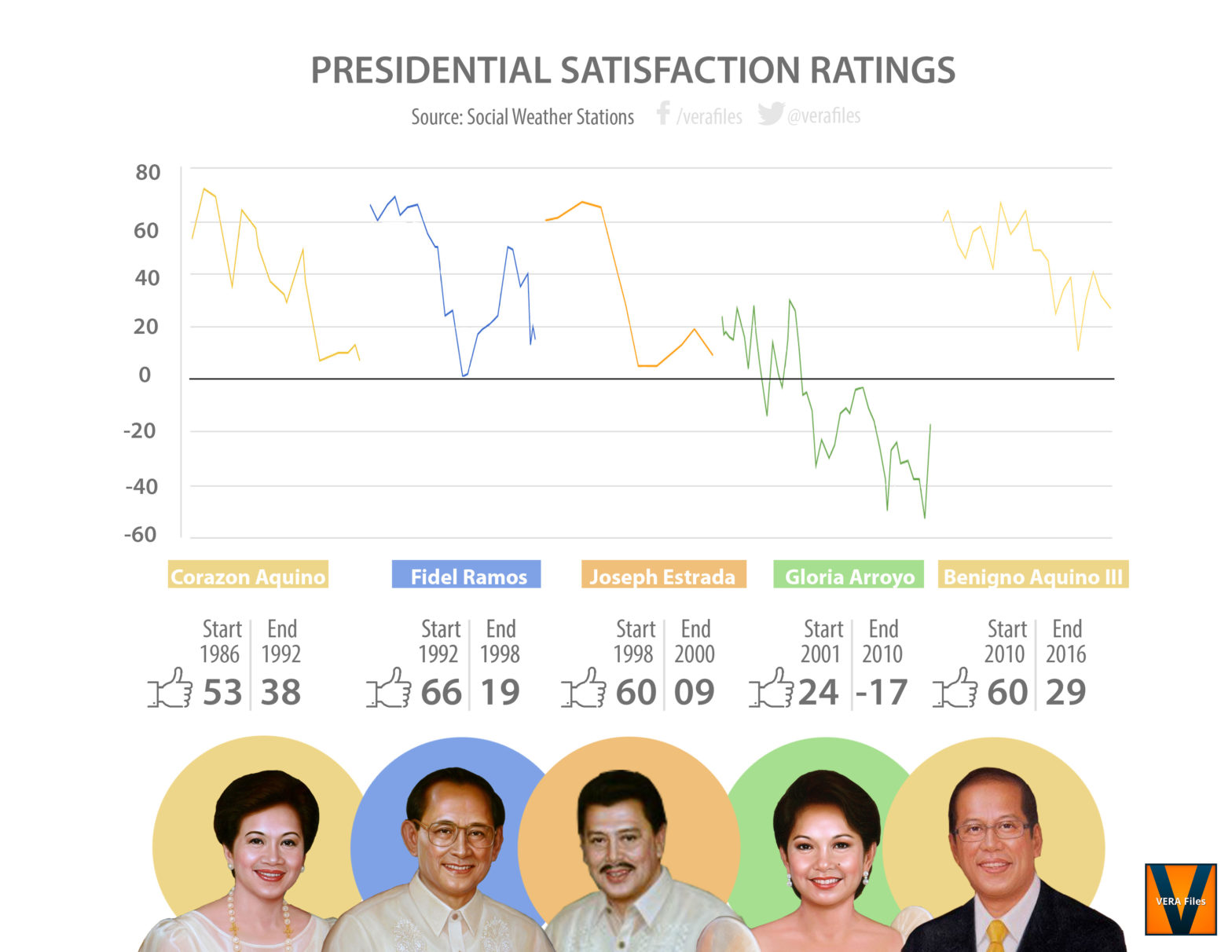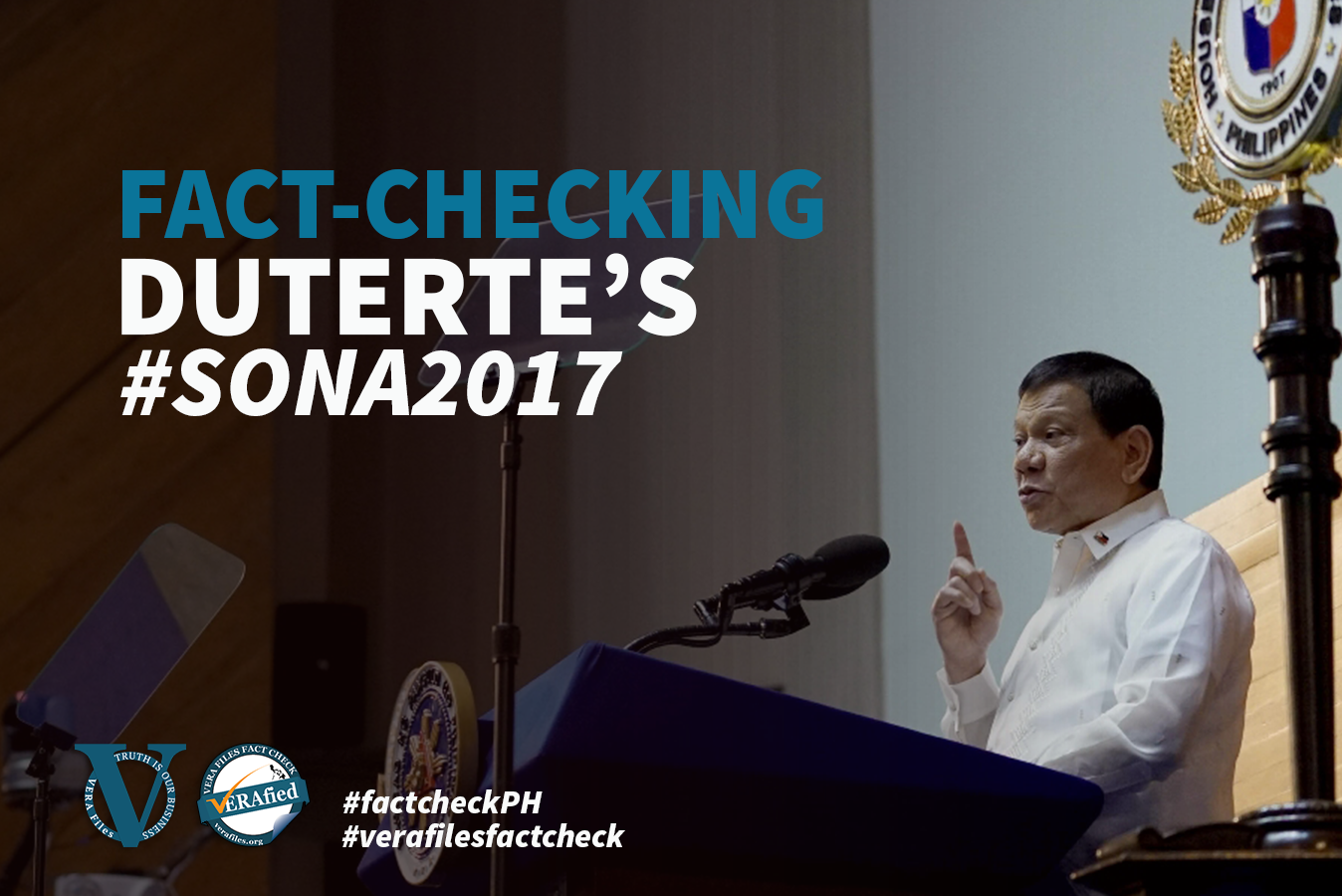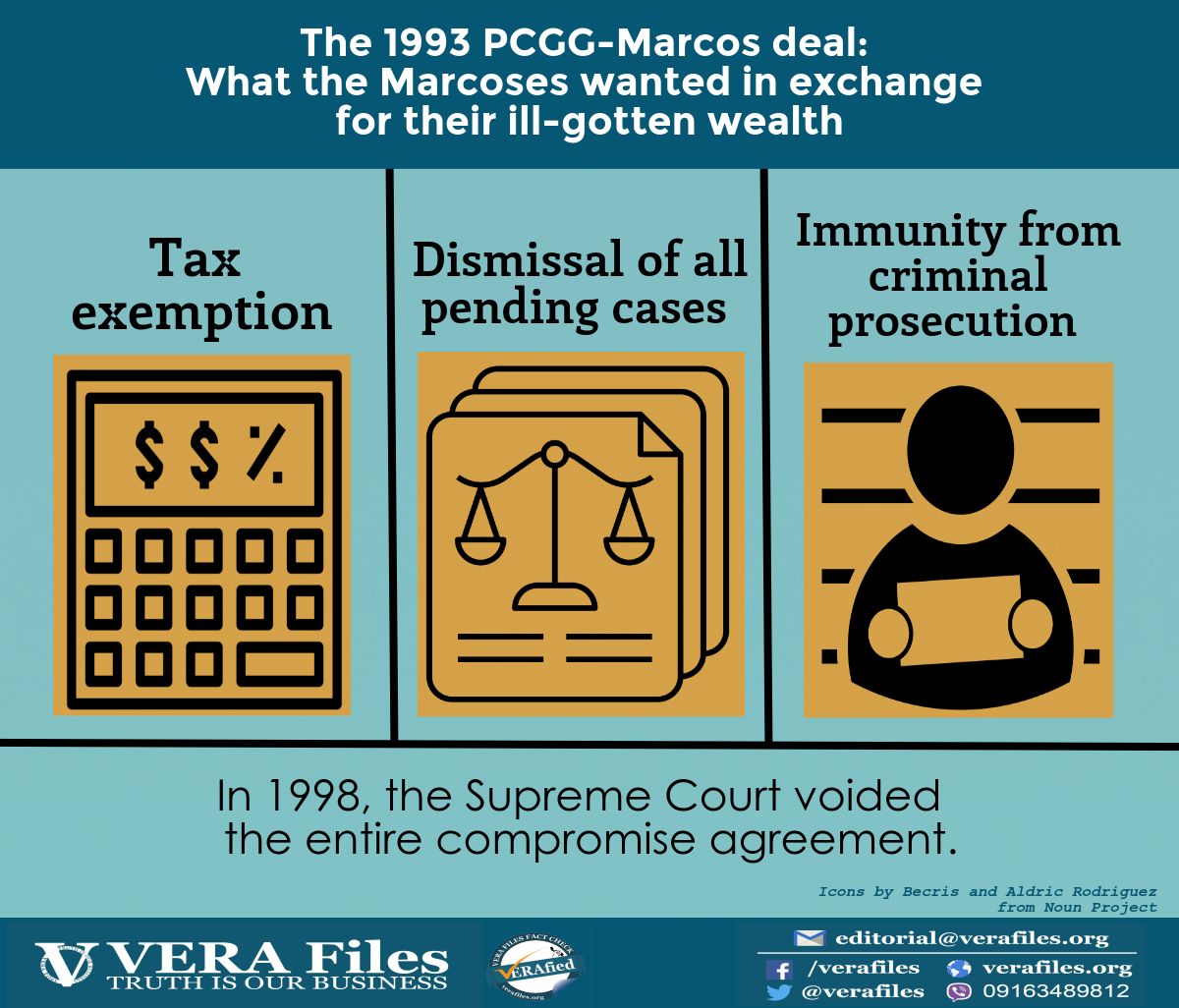![]()
STATEMENT: In his inaugural address on June 30, President Rodrigo Duterte claimed an “erosion” of trust in government is the real problem confronting the Philippines.
“Erosion of faith and trust in government—that is the real problem that confronts us. Resulting therefrom, I see the erosion of the people’s trust in our country’s leaders; the erosion of faith in our judicial system; the erosion of confidence in the capacity of our public servants to make the people’s lives better, safer and healthier,” he said.
Source: President Rodrigo Roa Duterte’s inaugural address
FACT: Contrary to what he claimed in his inaugural address, Duterte starts his term at a time that people have trust in their government, according to surveys. In fact, he is taking off on the heels of one of the most trusted administrations after Martial Law as far as satisfaction ratings are concerned.
According to Social Weather Stations (SWS) surveys from 1986 to 2016, former president Benigno Aquino III had a satisfaction rating of +29 points as of July 2016. This net satisfaction rating was higher than that of any of the other post-EDSA presidents at the end of their term. The Cabinet, the legislature and the judiciary during his term similarly received relatively high satisfaction ratings.
The ratings of Benigno Aquino’s administration ranged from “moderate” to “good,” as per SWS classification.
The SWS categorizes net satisfaction ratings as follows:
| Rating | Equivalent |
| At least +70 | Excellent |
| +50 to +69 | Very good |
| +30 to +49 | Good |
| +10 to +29 | Moderate |
| +9 to -9 | Neutral |
| -10 to -29 | Poor |
| -30 to -49 | Bad |
| -50 to -69 | Very bad |
| -70 and below | Execrable |
Here are the satisfaction ratings of the three branches of government from the term of former president Corazon Aquino to present, analyzed:
EXECUTIVE
President
From Corazon Aquino to her son, SWS surveys clearly show net satisfaction ratings of five presidents dropped from when they took office to when they stepped down.

Though public trust seemed to have been in flux over the years, Benigno Aquino’s term received the highest ratings among all the post-Martial Law presidents.
His mother, Corazon Aquino, suffered from a drastic plummet in trust ratings, starting off with +53 and ending with +7 in 1992. Her detractors, among them the late journalist Luis Beltran, criticized her governance as incompetent.
Ramos’ constantly high ratings have been credited to the economic boom and political stability. He would have the highest recorded first rating: +66. When he stepped down, the rating would be down to +19, marred by the shock of the Asian financial crisis: low, but not rock bottom for the administration which dropped to as low as +1 in October 1995, the same year he failed to save migrant worker Flor Contemplacion from being hanged in Singapore.
Joseph Estrada’s ratings ranged from ceiling high to low. This, in a short term of 31 months before corruption issues ultimately led to him being convicted for plunder.
The former actor began with 60 percent. Just before he was ousted, his satisfaction ratings dropped to 9 percent.
Gloria Macapagal-Arroyo was off to a rocky start at a 24-percent net satisfaction rating in March 2001.
Her ratings significantly rose in 2004 to 33 percent when she ran for president, but went downhill after the “Hello, Garci scandal,” the P728-million fertilizer fund scam and other scandals broke. She mostly received negative ratings.
Of the five, Benigno Aquino III left the Palace with the highest satisfaction ratings this July: +29.
Cabinet
Since the overthrow of Ferdinand Marcos in 1986, Benigno Aquino’s Cabinet throughout his six-year term had a consistently high trust ratings, exiting with +22, the highest end-of-term Cabinet satisfaction rating since 1992.
Corazon Aquino’s Cabinet suffered from consistently negative ratings, according to the data available, with -16 being the lowest recorded Cabinet rating in all of the administrations after Martial Law. She suffered from fluctuating, sometimes plummeting, satisfaction ratings as the president.
Ramos, despite having 28 cabinet members resign on his watch, had ended his term with +1, 16 points lower than when he started.
Arroyo maintained Estrada’s Cabinets’ positive rating with +14 when she assumed the presidency in 2001. However, from +17 in July 2001, trust ratings plummeted to +2 just two months after.
This followed the resignation of the so-called “Hyatt 10”— Arroyo’s seven cabinet members and three government agency heads, including Social Welfare Secretary Corazon “Dinky” Soliman, Budget Secretary Florencio Abad and Finance Secretary Cesar Purisima—over the election scandal.
Benigno Aquino’s Cabinet members never received a negative rating. The lowest was a +7 in June 2014, which would again rise by 11 points in the next quarter.
LEGISLATIVE
House of Representatives and the Senate
With net satisfaction ratings of +41 (Senate) and +29 (House), the 16th Congress recorded the highest end-of-term satisfaction ratings in decades. According to data from SWS surveys, the Senate during Benigno Aquino’s administration garnered a high of +67 satisfaction rating and the House of Representative, +42, in August 2012, riding on the high of the Daang Matuwid program.
This is unlike the Senate and House under Corazon Aquino, which garnered a low of -1 and a measly +2 during her watch. Throughout her administration, Congress was plagued with issues such as the U.S. Bases Extension Treaty, rolling electrical blackouts and drought.
Benigno Aquino’s Congress garnered rating declines following controversies surrounding the Priority Development Assistance Fund (PDAF) and the President’s Disbursement Acceleration Program (DAP), which was declared “unconstitutional” by the Supreme Court.
This brought recorded lows to the Daang Matuwid administration of net satisfaction ratings of only +12 for the Senate and +13 for the House in March 2014, the lowest in his six-year term.
However, by the time Benigno Aquino transferred the seat of power to Duterte, the Senate had achieved an average net satisfaction rating of +41 and the House, +27.
Arroyo’s Congress recorded the lowest satisfaction rating in 30 years. A survey conducted in March 2005 gave the Senate a -3 net satisfaction rating, and the House -9.
The low rating is further magnified by the average net satisfaction survey of +22 by the Senate and +17 by the House under Estrada. Plagued by numerous allegations of cronyism, incompetence and corruption, the Senate experienced a low +1 net satisfaction rating and the House, a -2 in December 1999.
JUDICIARY
Supreme Court
Contrary to Duterte’s pronouncement of the erosion of public trust in the judiciary, data from SWS surveys reveal more of a constant fluctuation than a consistent downward trend.
With a +36 net satisfaction rating as of April 2016, the Supreme Court during Benigno Aquino’s presidency had the highest end-of-term rating since Estrada was impeached in 2000, when the tribunal’s ratings peaked at +41.
The most unpopular Chief Justice, according to SWS survey results, is the late Renato Corona, who was impeached by a 20-3 vote by the members of the Senate on Dec. 12, 2011 for failing to properly disclose his statement of assets, liabilities and networth. In May 2012, Corona’s satisfaction rating, already teetering on the high negatives, hit rock bottom at -44, the lowest recorded rating for a Chief Justice since 1990.
While the rating for the SC as a whole dipped 14 points, it remained positive at +13 during the period. During Corona’s trial, the ratings of the Supreme Court never dipped below +20 points.
Among the chief justices, Claudio Teehankee of Corazon Aquino’s term enjoyed the highest satisfaction rating: +52 in October 1986.
Satisfaction ratings of the succeeding chief justices gradually fell and would only rise in August 2012, when Associate Justice Antonio Carpio briefly acted as the Chief Justice–from May 30 to August 25, 2012–after Corona was impeached.
During Carpio’s short stint as acting chief, the satisfaction rating for chief justice returned to the positive scale at +3.
The rating for chief justice further increased when current chief Ma. Lourdes Sereno took the helm of SC – it would rise to an average of +9.79 during the first four years of her term.
At +30.65, the net satisfaction rating of the judiciary during Benigno Aquino’s term was twice the rating during Arroyo’s term.
May 2005, a year after Arroyo’s presidential election, would be the only time the rating of the Supreme Court as a whole dipped below zero.
Source: Social Weather Stations (SWS) Satisfaction ratings
– Allan Yves Briones, Paul John Domalaon, Nicole-Anne Lagrimas and Arianne Christian Tapao
(The contributors are University of the Philippines students writing for VERA Files as part of their internship.)






